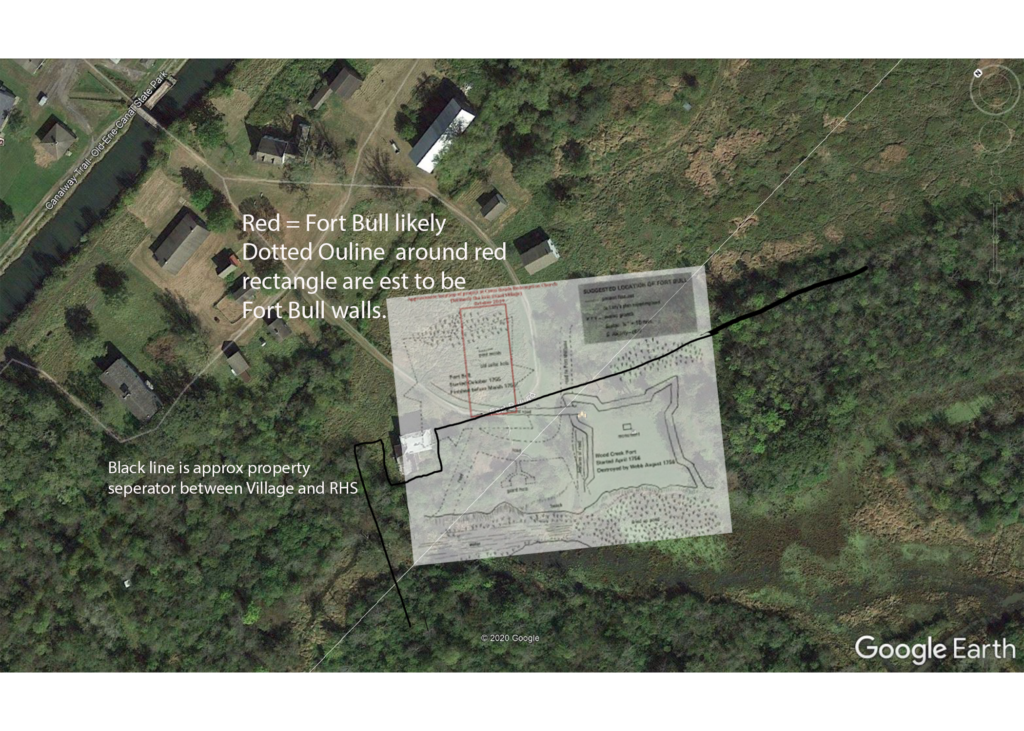Fort Bull / Fort Wood Creek
* The reference to Fort Bull and Fort Wood Creek are for educational purposes only given the forts significance to the area of the City of Rome and the Country. It is not solitation to visit or promotion to visity any historical site not on Erie Canal Village property. The property known as Fort Bull monument / Fort Woodcreek is owned and managed by Rome Historical Society. Access is only granted by Rome Historical Society. Rome Historical Society is not permitting visitors to Erie Canal Village to vist the site without permission of the Rome HIstorical Society and they considered visiting the site trespassing.
Over 200 years ago, during the French and Indian Wars (1755-1762), the Rome area was very important in terms of transportation. The site of the Oneida Carry, a one and one half mile portage between the Mohawk River and Wood Creek was used by the British army to carry supplies to its fort at Oswego and to various places on the Great Lakes. It was the only place south of the St. Lawrence River, controlled by the French and north of Georgia where goods could be transported to the western parts of the British Colonies in North America. The English build several forts at the carry at this time.
in 1755, the British build two small “magazines”, one at each end of the carry to support troops and to aid the passage of cargo farther west. Fort Williams was build on the Mohawk near the Lower Landing and Fort Bull was built on Wood Creek near a logical campsite for these travelers.
On March 27, 1756, Fort Bull was attacked by the French and Indian troops lead by Lt. Saspard De Leary, an engineer in the French army. The troops came from Montreal up the St. Lawrence River to La Presentation (Ogdensburg) and then south using the Black River and Boonville Gorge to the Oneida Carry.
The Fort, manned by about 50 soldiers, was lightly defended and De Leary’s 300 troops destroyed it within four hours. Also fighting a sell party from Fort Williams. During the battle, the powder magazine exploded all but destroying the fort.
The British built several other forts in the area during the war. In 1756, additional forts were built at the Lower landing, Fort Craven, at the upper landing, Fort Newport and on Wood Creek, Fort Wood Creek (to replace Fort Bull) and Fort Rickey. These forts were destroyed after the British were defeated at Oswego, and the troops at the Carry retreated down the Mohawk River. In 1758, the British returned to the area and build a larger fort, Fort Stanwix to guard the carry.
The Search for Fort Bull
December 8, 2020 (Rome, NY) Erie Canal Village, along with its management group, Erie Canal Heritage Park and Museums, is expanding a search for Fort Bull previously conducted by the Rome Historical Society. The site currently marked as Fort Bull is believed to actually be the footprint of Fort Woodcreek, with the older Fort Bull’s exact location still unknown. There have been several theories as to Fort Bull’s actual location but none have been verified through archeological findings.
A survey firm has been retained to map the subsurface ground area with ground penetrating radar. An archeologist has also been engaged who will review the findings and provide a separate report.
One suggestion is that the Fort Bull site is believed to be in the Village south green loop. The area suggested is based on a book and scientific sudies published by Gilbert Hagerty.
This placement is derived by placing historical maps of Fort Bull over the existing areal photos of Wood Creek. See picture below:

